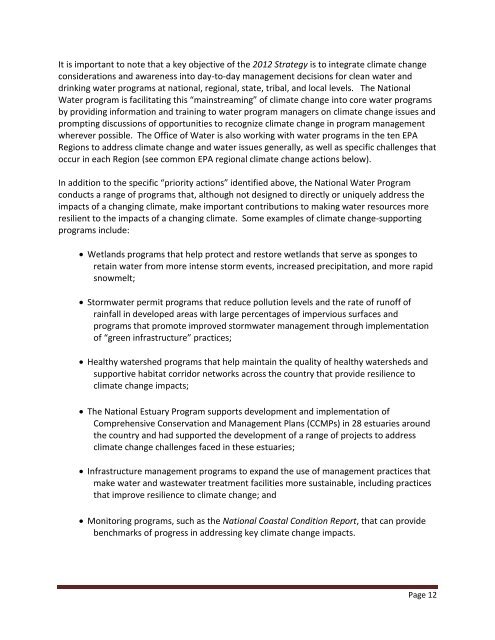OW-climate-change-adaptation-plan
OW-climate-change-adaptation-plan
OW-climate-change-adaptation-plan
You also want an ePaper? Increase the reach of your titles
YUMPU automatically turns print PDFs into web optimized ePapers that Google loves.
It is important to note that a key objective of the 2012 Strategy is to integrate <strong>climate</strong> <strong>change</strong><br />
considerations and awareness into day-to-day management decisions for clean water and<br />
drinking water programs at national, regional, state, tribal, and local levels. The National<br />
Water program is facilitating this “mainstreaming” of <strong>climate</strong> <strong>change</strong> into core water programs<br />
by providing information and training to water program managers on <strong>climate</strong> <strong>change</strong> issues and<br />
prompting discussions of opportunities to recognize <strong>climate</strong> <strong>change</strong> in program management<br />
wherever possible. The Office of Water is also working with water programs in the ten EPA<br />
Regions to address <strong>climate</strong> <strong>change</strong> and water issues generally, as well as specific challenges that<br />
occur in each Region (see common EPA regional <strong>climate</strong> <strong>change</strong> actions below).<br />
In addition to the specific “priority actions” identified above, the National Water Program<br />
conducts a range of programs that, although not designed to directly or uniquely address the<br />
impacts of a changing <strong>climate</strong>, make important contributions to making water resources more<br />
resilient to the impacts of a changing <strong>climate</strong>. Some examples of <strong>climate</strong> <strong>change</strong>-supporting<br />
programs include:<br />
Wetlands programs that help protect and restore wetlands that serve as sponges to<br />
retain water from more intense storm events, increased precipitation, and more rapid<br />
snowmelt;<br />
Stormwater permit programs that reduce pollution levels and the rate of runoff of<br />
rainfall in developed areas with large percentages of impervious surfaces and<br />
programs that promote improved stormwater management through implementation<br />
of “green infrastructure” practices;<br />
Healthy watershed programs that help maintain the quality of healthy watersheds and<br />
supportive habitat corridor networks across the country that provide resilience to<br />
<strong>climate</strong> <strong>change</strong> impacts;<br />
The National Estuary Program supports development and implementation of<br />
Comprehensive Conservation and Management Plans (CCMPs) in 28 estuaries around<br />
the country and had supported the development of a range of projects to address<br />
<strong>climate</strong> <strong>change</strong> challenges faced in these estuaries;<br />
Infrastructure management programs to expand the use of management practices that<br />
make water and wastewater treatment facilities more sustainable, including practices<br />
that improve resilience to <strong>climate</strong> <strong>change</strong>; and<br />
Monitoring programs, such as the National Coastal Condition Report, that can provide<br />
benchmarks of progress in addressing key <strong>climate</strong> <strong>change</strong> impacts.<br />
Page 12


